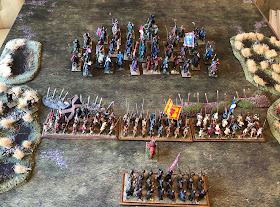I enjoyed the film, which thankfully didn't repeat the embarrassing nonsense that was Braveheart. However, it was not without its historical inaccuracies. The film portrays Edward I's death before the battle when he actually died some two months later. We also had Edward II stomping across the battlefield, when not only was he not the king, but it is highly unlikely he was there at all.
So what do we know about the battle?
After his coronation and the disaster of Methven in June 1306, Bruce traveled around the west of Scotland, rebuilding his forces and alliances. In 1307, he conducted a guerrilla war until he had sufficient troops to take on the English occupation army and their Scots allies. It is important not to view these wars through modern nationalist eyes. This was also a civil war between the Bruce and the Comyn families, which Edward exploited for his own purposes. In the feudal world, a man owed loyalty to his family, not his country.
Bruce's forces won a victory at Glen Trool in March 1307. Over very rough ground, it is likely to have been little more than a skirmish. None the less, it caused Edward's commander in Scotland, Sir Aymer de Valence (Brother in law to the murdered Comyn) to gather a larger force and advance into the Bruce Earldom of Carrick (largely modern Ayrshire). This was a mounted force with estimates varying between 1500 and 3000 strong.
Bruce picked a strong defensive position and had around 600 spearmen. The road narrowed through boggy ground, which Bruce strengthened with ditches and stakes. Crucially, Valence had no bowmen so was forced to charge the spearmen frontally over a narrow frontage which negated his numerical superiority. The first division failed and the resulting confusion caused the rest to flee the battlefield. Bruce was unable to pursue on foot, so casualties were fairly low on both sides.
The significance of Loudoun Hill was not the scale of the victory, but rather the propaganda value. Even more important was the death of Edward I, which is resulted in his heir having to concentrate on matters in England. This allowed Bruce to win the civil war and prepare for the next proper invasion, which culminated in Bannockburn.
The battle scene in the film itself was pretty accurate, given it was filmed in a park north of Glasgow, with the distinctive Loudoun Hill superimposed. No woad, tartan, tree trunk pikes, or the missing bridge - as in Braveheart!
I live fairly near the battlefield and have passed through it many times. Usually on the start or end of a long journey south, so I have never properly explored it. Inspired by the film, I set off last Friday to rectify that. It was a suitably misty morning, very atmospheric for the task in hand.
We don't know exactly where the battle was fought, but Historic Scotland's battlefield inventory gives a decent estimate. The battlefield has had some modern development - a couple of farms, small reservoirs, a sand quarry, and a disused railway. The modern A71 largely follows the Roman Road, which is likely to be the road described in the sources. The ground around the hill is very rough going with the River Irvine cutting through it. This leaves really only one likely site near Allanton Farm and the sand quarry. Probably not exactly where it is marked on the Ordnance Survey map. As you can see from this photo, the ground is very flat in the eastern approach to the battlefield.
I decided to have a look at the likely site from different angles. Starting with Loudoun Hill itself.
Then I approached the site from a spur of high ground above the river from the east.
And finally, from the road itself or the southern and western view.
Walking a battlefield is one experience, refighting the battle on the tabletop is another. I collected a 28mm army for this period in order to complete a display game for the Bannockburn 700th anniversary in 2014.
Valence's first division advances. As our main source for the battle, the chronicler John Barbour relates: "Their basnets were all burnished bright and flamed in the rays of the sun and their shields, spears and pennons lighted up all the field."
And finally, the clash of spear and knight.
The film is a worth a watch, but as ever, it's always worth visiting the actual battlefield.










No comments:
Post a Comment